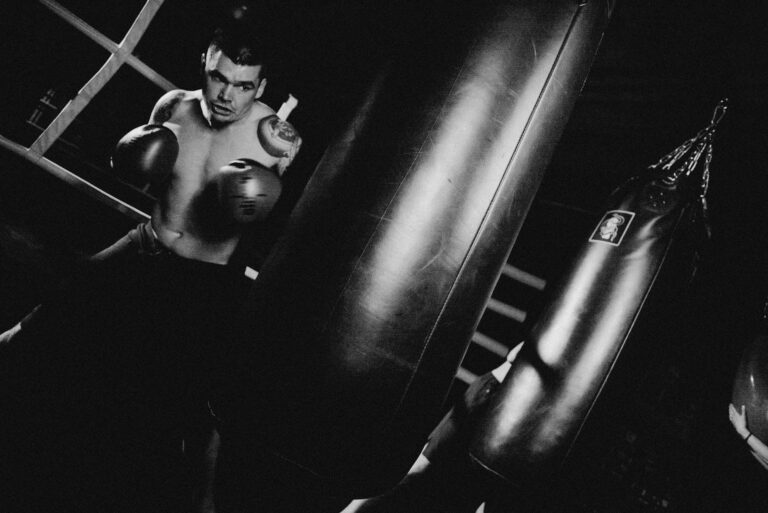12 Types of Watches: All You Need To Know in One Post
I’ve been in the watch game a long time, and my collection is still nowhere near where I would’ve wanted. There are just so many types of watches to choose from that it’s almost impossible to pick just one when the extra money is available. And the truth is, I’m pretty happy with my modest collection at the moment, but there are plenty of types of watches I wouldn’t mind calling my own.
If you’re like me and you start to feel overwhelmed by all the different kinds of watches there are available for men these days, don’t worry. This guide will explain the most important information that you need to know about the different types of watches, their styles, and their features.

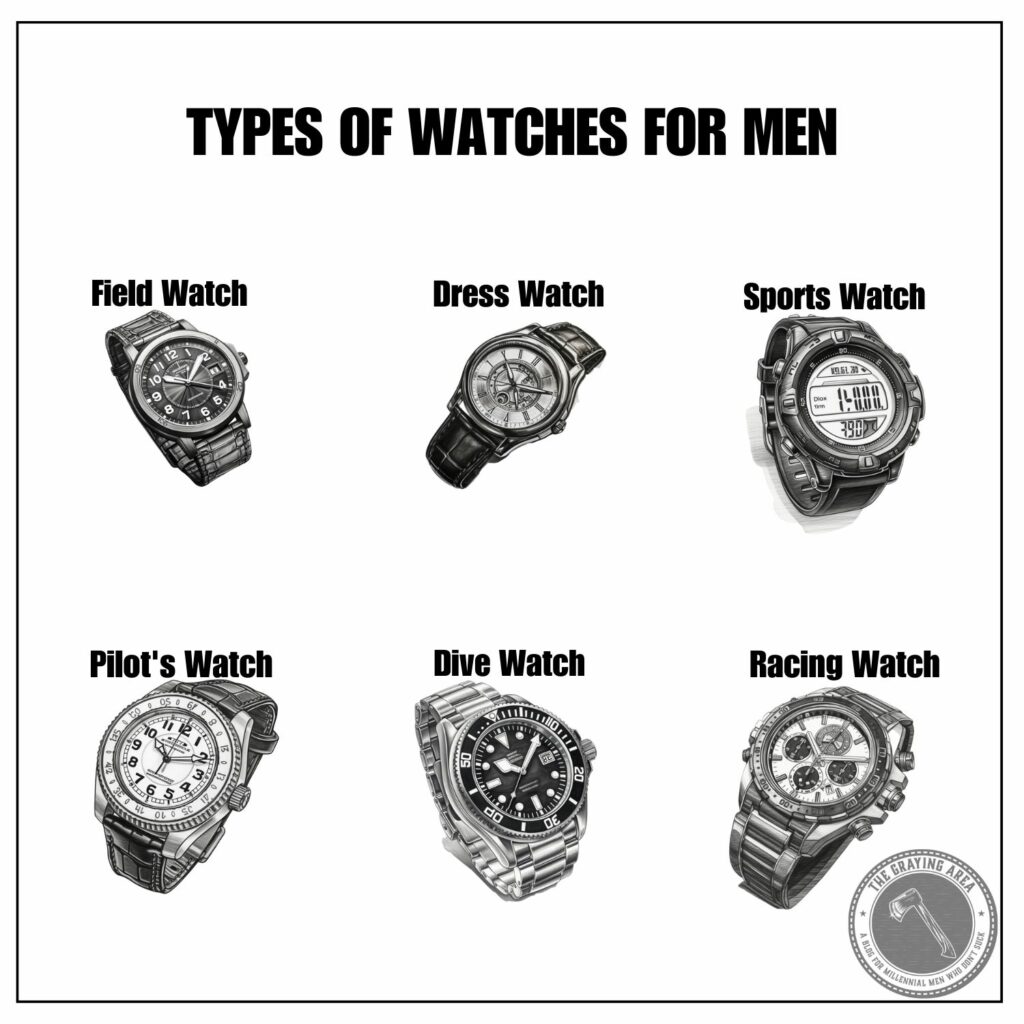
Types of Watches
We’ll learn a bit more about the different types of watch movements, watch faces, and watch features in a little bit. Right now, it’s time to look at the types of watches that men will commonly find while watch shopping. We’ll go over each briefly and likely expand on them in future articles—after all, I do think that a good watch is something that men should own by the time they’re 30.
Sports Watches
Sports watches are the most casual watches. These types of watches are usually quartz movements with digital faces, and they can be worn running, swimming, or during any other range of activities. Most would consider these normal watches, but, a casual watch like this is often too laid back to be worn anywhere but to the gym or on a bike.
The most common sports watches are G-Shocks and Garmins, but some consider dive or pilot watches to be sports watches, as well. I do, but most consider a digital watch to be sportier.
Pocket Watches
Pocket watches aren’t common at all today, but they’re still worth mentioning, as that’s where the whole story of all these types of watches started. A pocket watch is essentially a small clock on the end of a chain. Men used to wear this type of watch in their vest pockets and use them to track time for trains and other old-timey events. They usually featured a mechanical movement, and they’re one of the most iconic watch styles today.

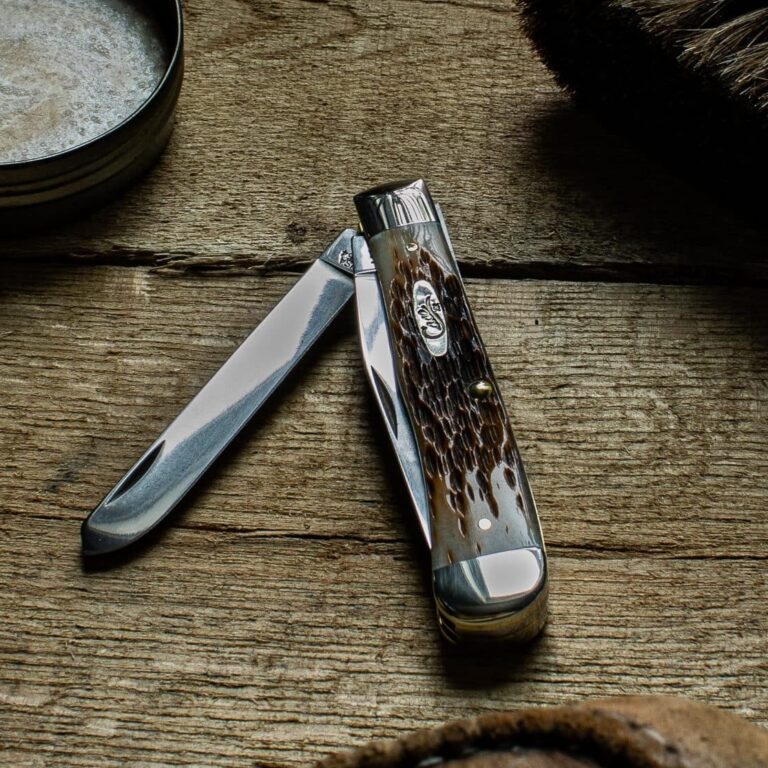
The Spey Blade: The Best Knife Shape in 2024
I’m pretty deep into the pocket knife and EDC world. I’ve carried these items for decades, and I’ve been writing about them for years. But, only recently did I discover my new favorite blade shape: The spey blade. Now, that’s a bit of bull. I’ve known about the spey shape since I was about 10…
Pilot Watch or Aviator Watch
Pilot’s watches were designed to be used as a tool in a cockpit, finding the first real use in World War I. Also called aviator watches, these devices had large faces with contrasting dials so pilots could quickly see the time, calculate how long they’d been flying, and stay safe. Common pilot watches today include Flieger-style dials from companies like Sinn, Stowa, Laco, and IWC.
It’s also worth noting that some of the modern pilot watches of today are actually GMT watches. A GMT watch has a rotating bezel and an additional hand on the dial. The hand can be set to represent a second time zone, while the bezel can be set to one other time zone.
Skeleton Watches
Skeleton watches are an acquired taste, but they essentially put the watch’s movement inside the case on display. Users can see the main springs and gears turning, all working together to keep the time. They’re a great way to display a revolutionary watch movement, and major luxury watch manufacturers like Richard Mille, Cartier, Patek Philippe, and even Audemars Piguet make skeleton watches, and these are the real deal.

Chronograph Watches/Racing Watches
Chronograph watches, or racing watches, are all about timing things. For those unfamiliar, a chronograph is a stopwatch, and race car drivers used to use these racing watches to time their laps inside the vehicle. Today, these types of watches still have a racy flair to them, though many are often used as pilot’s watches now, as well. Popular chronograph brands include Omega, Seiko, Tag Heuer, and some of Rolex’s most famous and expensive watches.
Military or Field Watches
Military watches or field watches are built to be rugged. A field watch is often quartz-based to make it accurate and durable, allowing multiple operatives to synchronize their watches on a mission. A field watch will also typically feature durable materials like rubber or canvas and may feature a compass built-into the dial or case.
Common field watches come from inexpensive brands like Seiko, Bulova, Laco, Marathon, Luminox, Hamilton, and of course, the Casio G-Shock. They’re tough and durable and can withstand the rigors of a field service or even a battleground.
Chronometer watches
The most accurate automatic watch options are chronometers. These watches have to be COSC certified by the Official Swiss Chronometer Testing Institute. The most common chronometers include high-end sports watches like the Rolex Daytona, the Omega Speedmaster, and the Breitling Navitimer.
Hybrid Watch Display
Hybrid watches are a really cool design. These watches typically feature a common look, such as an analog face and a round dial. However, inside the dial, there may be a digital screen that displays the time. This allows the user to quickly look at the time with their watch’s hands or to look closely at the digital time for an accurate reading.
One watch that popularized the hybrid watch display was the Seiko Arnie, or the modern SNJ025. This watches features quartz movement and rugged construction, and our man Arnold Schwarzenegger wore the original version in the movies “Commando” and “Predator.”
Doctors and Nurses Watches
Doctors and nurses watches are something of a niche-type watch, but they can be important anyway. These watches usually feature a pulsometer around the outside of the dial. This helps the healthcare staff by allowing them to measure heartbeats using a hand that resembles the second hand.
There are two common variants of the pulsometer: 15 pulsations and 30 pulsations. How these watches work is that as the wearer starts the timing hand (or seconds hand hits 12), they start to count heartbeats. When they hit 15 (or 30), they check to see where this small hand is on the dial. The number the hand is pointing to will calculate the patient’s heart beat.
Pulsometers are largely outdated today, and most doctors don’t even check heart rate anymore. But they’re still a cool piece to have in a watch collection.
Fashion Watch
Fashion watches come in a wide range of watch styles and types. They may be a sport watches, dress watches, diver watches, or casual watches. The telling feature is if the watch is made by a clothing brand, it’s probably a fashion watch. These watches are typically overpriced and poor quality, and I’d suggest staying away from them.
There are some luxury watches made by fashion brands, however. For instance, Cartier is a jewelry maker that also makes watches, and these are anything but fashion watches.

Dive Watches
Dive watches are some of the most popular types of sport watches. These types of watches were designed for scuba divers and feature a rotating timing bezel that helps them track the time they’ve been underwater so they know how much air is left in their tank. Diving watches require a screw-down crown and a gasketed caseback to make them waterproof under extreme pressure.
As the diver prepares to drop into the water, they turn the bezel on their dive watch so the main pip (the dot on the bezel) is aligned with their minutes hand. When they go underwater, they can then check the minutes hand position relative to the pip to determine how long they’ve been underwater. A real dive watch will have a uni-directional bezel that can’t be clicked backward on accident. If it the bezel on a dive watch clicks forward, the diver will simply think they have less time they can actually do, allowing them to come back to the surface safely.
It’s important that a dive watch be an accurate watch. So, rather than relying on a mechanical watch movement, most divers now use diving computers to track their time and pressure gauges to monitor their air level. However, popular diving watches include the Rolex Submariner, the Rolex Deepsea, the Citizen Promaster, the Seiko SKX, the Omega Seamaster, the Blancpain Fifty Fathoms, and the Breitling Superocean. These diving watches are actually somewhat iconic, and many watch collections contain more than one.
Dress Watches
Dress watches are designed to be worn with a suit or professional attire. Dress watches’ cases are typically made from precious metals, they feature luxurious leather straps and are thin enough to slide under a dress shirt cuff. They have relatively simple dials, often without numbers but just indices or bars to indicate the hours, and they rarely have more than 3 hands (two hands, very often!).
A dress watch says a lot about a man. It shows that he cares about the details, that time matters, and that he knows how to dress. When possible, the strap should match the belt and shoes, and the case should match the wearer’s wedding ring or other jewelry. And also, never wear a dress watch to a formal event or with a tuxedo. It doesn’t matter nice your dress watch is, it’s inappropriate for these affairs (and if you need help figuring out which buttons to button on that suit jacket, I’ve got you covered with this guide).
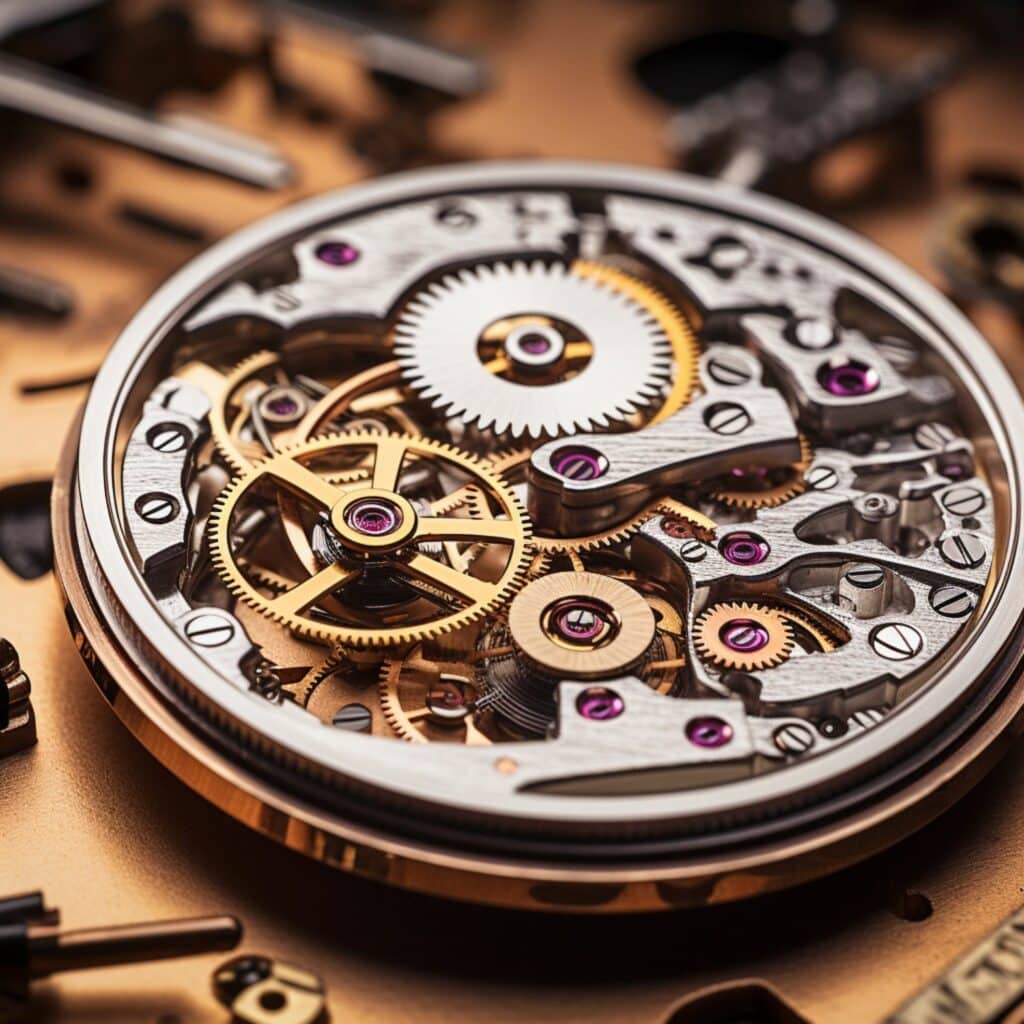
Types of Watch Movements
Let’s talk about the different types of watch movements. Movements refer to the machines inside the watch that keep it running. In some cases, the movement is like the heart of the watch. In other cases, it’s like the brain. It depends on the watch and the movement type, and we’ll cover the most common right here.
Mechanical Movement
Mechanical watches have movements insides full of springs, wheels, gears, and other small mechanical items that all work together to keep time. These watches need to be wound by hand, or manually, in order to keep them running. They typically have analog faces, may feature several complications, and they’re typically fairly expensive.
To wind a mechanical watch, the user simply pulls out the crown (the knob used to adjust the time) to the right correct position and carefully twists it. This winds a spring inside that then keeps the watch moving, often for several days at a time.


The Best Hand Tools List for Guys: 25 Must-Have Pieces
Being able to build something or repair the things that surround you every day is one of the greatest skills a guy can have. It’s a skill that is not only helpful but will also save you money. Instead of calling the repair guy, you can grab your toolbox and get to work. But you…
Automatic Watches
Automatic watches are similar to mechanical watches in that they’re full of gears and springs that help keep time. They have analog faces with numbers and hands, and they may have complications as well. Where they differ is in how they wind. In fact, all automatic watches are mechanical, but not all mechanical movements are automatic. Let’s look at why:
Rather than how a mechanical watch requires the wearer to twist the crown, an automatic watch windows on its own. It has a weighted rotor behind the caseback that swings as the wearer moves their arm. Every time the rotor moves, it winds the watch movement.
Quartz Watches
A quartz watch is essentially a computer on the wrist. These watches use batteries that send electrical pulses to the different chips and resistors to tell the watch to keep time. When the battery dies, the back of the watch can be opened and the battery replaced. Quartz watches are usually inexpensive, but a digital watch is usually extremely accurate. And, as a rule, if you can hear the watch ticking, it’s likely a quartz-based movement.
Solar Watches
Solar watches have small photovoltaic cells behind their dials that collect light. This can be light from the sun, an overhead light in an office, or from a computer monitor. This cell collects the light energy and turns it into electricity, which then charges a small battery inside the watch. From that point forward, the watch operates like a standard quartz-powered watch.
Kinetic Watches
Kinetic watches are similar to an automatic watch in that movement keeps it running. However, they’re also similar to quartz watches in that the electricity is stored in a battery and used to operate the movement. A kinetic watch can be very accurate as well, and they’re usually fairly affordable.
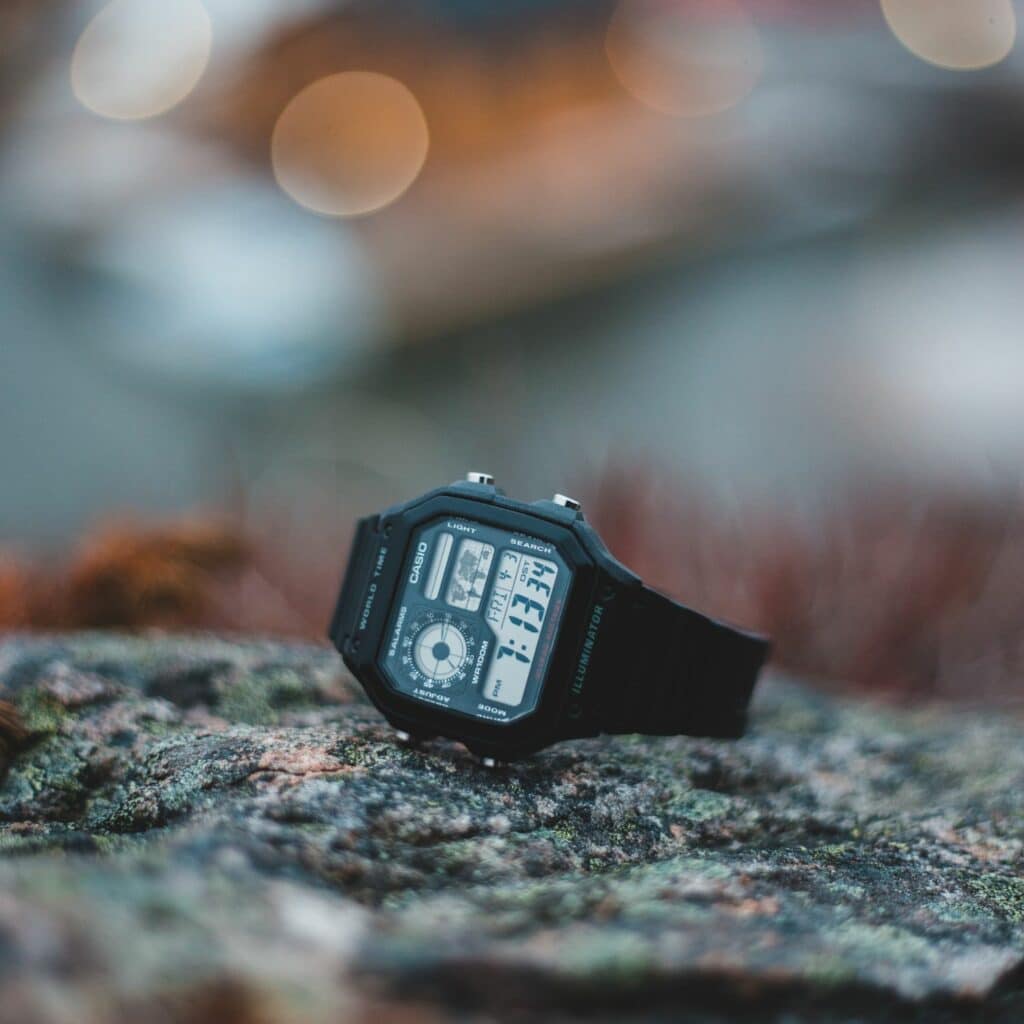
Types of Watch Dials or Displays
When we think of watches, the first thing that comes to mind is usually the watch face, dial, or display. There are several types of watch dials or displays, and it’s important to know what they are so you can choose the best possible watch. For those who don’t wear watches often, some features or styles might surprise you. For watch enthusiasts, you likely own several of these already.
Analog Watches
For those who aren’t big watch collectors, analog watches are seen as the “old school” display. An analog watch will typically have at least three hands (hour, minute, and seconds hand) and they rotate clockwise around the watch’s face to display the time. They come in a wide range of styles and tastes, such as plain (they might not even have numbers) or with multiple complications. They’re also available as automatic, quartz, mechanical, kinetic, and solar watches.
Digital Watches
Once seen as a “kid’s watch, ” digital watches feature numerical displays that are easy to read. A digital watch can clearly display the time in an HH:MM format, ensuring that one quick look will tell the wearer the time. This makes them a quick and easy watch to grab when headed to the range, the gym, or a hike.
Digital watches frequently have additional features like days, calendars, illumination, alarms, and more. They’re almost always solar or quartz, as well. And, as mentioned, quartz movements are usually the most accurate watches despite their usually-low price.
Smart Watches
Smart watches are the new kids in town. these watches feature touchscreen watch face that allow the user to manipulate functions from their phones on their wrists. The wearer can text, take phone calls, set alarms, and even us voice commands from their smart watches. Smart watches generally feature built-in rechargeable batteries for convenience.
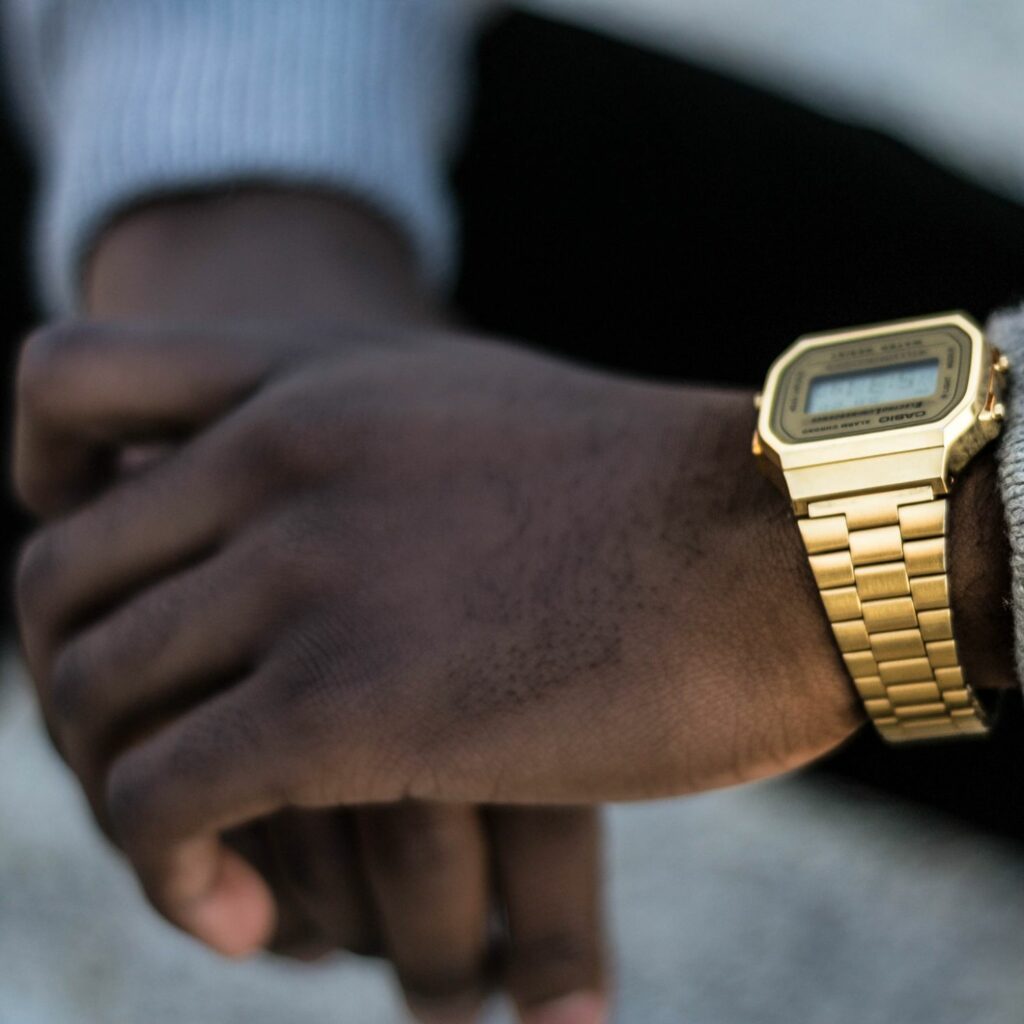
Watch Complications or Features
Moving on, let’s cover some of the most common watch complications. Complications are like the additional features that a watch can offer. They’re called complications because adding them to a mechanical or automatic movement requires a lot of complicated little parts working together harmoniously in order to work.
Date
The date complication is easily the most common. It can be found on any type of watch dial, and it displays the current date. These complications are synced with the hour hand to change over every two rotations at midnight to keep the wearer quite literally up to date. They’ve available on analog, digital, or smart watches and in all sorts of movement types.
Day
Another common complication is the day complication. This mechanism can be set to the current day, and it will change in order every night at midnight. These are common on quartz movement watches, and it’s easier to send an electrical pulse that simply snaps the day forward, while mechanical and automatic watches can take hours to change over.
Chronograph
Chronograph watches were designed for pilots and racecar drivers. These watches have stopwatches built into the watch movement. Wearers can start and stop the watch as they race, or keep track of how long they’ve been in the air.
Moon phase
Moon phase watches are high-class, and they track the current phase of the moon. Is this practical? Maybe if you’re a fisherman or sailor, but the average person will simply wear a moon phase because they’re incredibly cool. While moon phase complications are common, they’re usually found on mechanical or automatic watches. They’re also quite expensive, making them more common on luxury watches.
GMT
A GMT can track the time in more than one time zone, making them a great choice for a pilot watch. They typically have an additional hour hand that can be set to the time wherever the wearer wants to track. Some may also have a rotating bezel with 12-hour markers that the wearer can adjust for the correct time. Some also do their time telling in a 24-hour hour format for an easier reference for pilots and those who travel between time zones.


30 Badass Skills To Learn in 2024
Most self-improvement stuff sucks. But, as men, we should focus on bettering ourselves, especially as we age (that’s what we’re all about here at The Graying Area). While we’re all awesome in our own way, instead of sitting around an playing video games, there’s always room for new badass skills to learn to help broaden…
Lume
Lume is a feature that allows the wearer to see the time at night. This glow-in-the-dark material can be on the hands and markers on the dial. Digital watches have actual illumination, which lights up the face of the watch when the wearer presses the light button.
Timing Bezel
A timing bezel is a ring around the outside of the watch, usually found on dive watches. This rotating bezel allows the wear to set the main marker on the bezel to the position of the minutes hand and then use the bezel to time moving forward. This was originally used for scuba divers who needed to know how much air time they had left in their tank.
Slide Rule
Slide rules are really cool rotating bezels that have a wide variety of functions. They can be used to calculate speed and distance, fuel mileage, and even tips at a restaurant. Slide bezels can also be used as timing bezels or compasses, depending on the watch. How do all these functions work? I don’t know. I could only ever figure out how to use mine as a timing bezel and speed calculator.
World Timer
A world timer is a function that tracks the time zones across the world. The wearer can press a button on the side of the watch to select a new time zone (usually indicated on the watch dial) and the time hands will spring forward to the time in that area. This is an expensive complication, but many quartz watches feature world timers, as well.
Power Reserve
A power reserve indicator is often found on mechanical watches so users don’t forget to wind them. It’s usually a small indicator on the watch face and when it starts to get low, the wearer should remove the watch and wind the crown. This is a nice touch, especially for someone who doesn’t want their watch to stop.
Alarm
Just as one might guess, an alarm is a complication that sets off an audible sound at a prescribed time. These are most common on digital and quartz watches.
Your Turn
Did I cover all of the types of watches you were thinking of? Any watch styles I might’ve forgotten? Let me know if the comments below and I’ll add them to the article. Also, if you enjoy the content on TGA, be sure to sign up for the newsletter below. I send out weekly updates to let readers know about new posts, so that they never have to worry about missing a new article.

Enjoying learning about badass skills? What about reviews on products men actually use? Or just generally learning how to be a more useful man? THEN JOIN THE TGA MAILING LIST! Weekly content sent directly to your email address so you don’t miss any of the fresh content and useful advice we’re producing. Sign up below!
Watch Styles FAQs
That was a lot of background on the different types of watches, but there may still be some additional questions you need answered. The following are the most commonly asked questions about watch styles.
Are there different types of watches?
There are many different types of watches on the market. One could choose from a diving watch, racing watch, aviator watch, dress watch, digital watch, field watch, military watches, or another type of watch that suits their needs and style.
How many different kinds of watches are there?
This article highlights 12 different types of watches. There may be more options, but this list included the most common type of watch, some of the most expensive watches, and just about everything in between.
What are the three types of watches you need?
In my opinion, the three types of watches you need include a dress watch, a diving watch, and a digital watch.
What is the most common type of watch?
More often than not, the most common type of watch today is the smartwatch. However, digital watches are still popular, and men who wear dive watches often notice each other’s wristwear.
What is a high class watch?
High class watches are generally luxury watches, and there are a lot of options (and opinions). In my opinion, the best luxury watches are made by companies like Rolex, Omega, and Grand Seiko.
What types of watches are used nowadays?
Watches have come a long way since they were pocket watches attached to leather straps in World War One. Today, a common type of watch may include a dive watch, a racing watch, or a digital watch. Fashion watches are also popular, but they’re not advisable from my standpoint.



